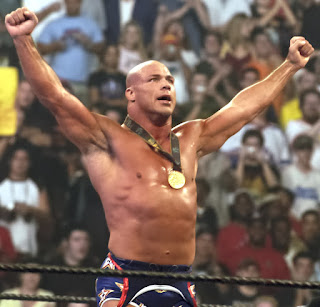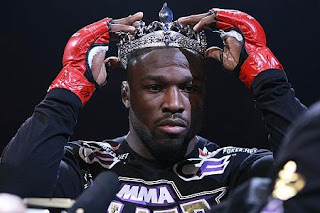Professional wrestling and mixed martial arts have once again been linked together. After being banished from Zuffa employ, Muhammed “King Mo” Lawal can be credited for continuing a conversation that some would like to see finally die. Last week it was announced that not only has the former Strikeforce champion signed with the number two MMA promotion in Bellator, but he has also inked a deal with their soon-to-be Spike TV network mate, the professional wrestling organization Total Nonstop Action Wrestling. This is a move that has the potential to truly change how mixed martial arts stars are created, as well as the way networks interact with mixed martial arts promotions in the future.
At first glance, the announcement may seem like nothing more than a ploy to grab attention by all three entities. Bellator is not going to catch the UFC any time soon, and has already lost one major star to its competitor in the form of Hector Lombard. TNA has made strides to find its niche under the massive shadow of the WWE, but hasn’t established any true momentum towards becoming a real factor in professional wrestling. Lawal was recently cut from the Strikeforce roster for what could be deemed “controversial reasons,” subsequent to a failed drug test and incendiary remarks made on Twitter. However, now that the three have announced plans to come together under the Spike network banner, it will be interesting to see how this partnership will work.
 Lawal has stated that he’s going to enter Bellator’s 205-pound tournament in early 2013, with the hopes of winning both the tournament and the title. While the tournament field has yet to be announced, one look at the light heavyweight division in that organization, and it’s easy to conclude that, if he isn’t already, he will quickly become favored to do so. Normally, training mixed martial arts isn’t something that can be done on a part time basis if championship-caliber success if the final goal. However, as a part of the TNA roster, Lawal may have found a way to achieve just that.
Lawal has stated that he’s going to enter Bellator’s 205-pound tournament in early 2013, with the hopes of winning both the tournament and the title. While the tournament field has yet to be announced, one look at the light heavyweight division in that organization, and it’s easy to conclude that, if he isn’t already, he will quickly become favored to do so. Normally, training mixed martial arts isn’t something that can be done on a part time basis if championship-caliber success if the final goal. However, as a part of the TNA roster, Lawal may have found a way to achieve just that.
TNA tapes content for a month’s worth of their weekly shows at the same location, meaning Lawal can travel to their studio location in Florida and complete multiple episodes in just a few days; this frees up his time to continue preparing for any fights that are booked. Scheduling concerns may arise when the organization begins a tour, but it wouldn’t be shocking if he was written out of shows during that time frame so he could remain in one place to continue training. The organization’s president, Dixie Carter, has stated that they intend to keep the professional wrestling storylines as close to real life as possible, which means they will work things around Lawal’s MMA career as needed.
On Bellator’s end, they may have found a new way to build star power as they attempt to attract or retain the kind of name talent that drives the UFC’s bottom line. This isn’t the first time that MMA and professional wrestling have been bedfellows. Josh Barnett, Kazushi Sakuraba, Ken Shamrock, and others have jumped back and forth into the wrestling right while fighting, and their fan bases exploded due to the practice. Even if you consider what Brock Lesnar did when he moved from the WWE to the UFC and back, you can tell that there is a buzz around big name stars when they are promoted correctly. If they can grasp both the MMA and professional wrestling fan bases and have them tune into both formats, the potential for cross-promotion between Bellator and TNA to build stars on both platforms is greatly increased.
 Another area to look at with this development is the role that Viacom and Spike will play. It was never a secret that Bellator lacked the deep pockets to be able to pay the price tags that accompanied big names such as Lawal. With the announcement of this signing, it seems that Viacom and the network support making moves to attract big stars to their platform, and are willing to financially support these moves. Fans have already begun speculating about the potential for bringing the soon-to-be free agent Quinton “Rampage” Jackson into the fold under a similar deal, as he has already participated in professional wrestling to an extent, and is a long-time wrestling fan that has not only previously expressed an interest in doing professional wrestling, but also has a long history of animosity with Lawal. The idea of Barnett being brought on has been tossed around, as he could be another potential signee if his past with the UFC results in him not being signed with the company. On a smaller scale, Bellator lightweight champion Michael Chandler and TNA wrestler/Olympian Kurt Angle were recently involved in a back-and-forth Twitter battle. These are only a few of the possibilities for Spike to use this partnership to build the stars needed to raise the profiles of both Bellator and TNA Wrestling.
Another area to look at with this development is the role that Viacom and Spike will play. It was never a secret that Bellator lacked the deep pockets to be able to pay the price tags that accompanied big names such as Lawal. With the announcement of this signing, it seems that Viacom and the network support making moves to attract big stars to their platform, and are willing to financially support these moves. Fans have already begun speculating about the potential for bringing the soon-to-be free agent Quinton “Rampage” Jackson into the fold under a similar deal, as he has already participated in professional wrestling to an extent, and is a long-time wrestling fan that has not only previously expressed an interest in doing professional wrestling, but also has a long history of animosity with Lawal. The idea of Barnett being brought on has been tossed around, as he could be another potential signee if his past with the UFC results in him not being signed with the company. On a smaller scale, Bellator lightweight champion Michael Chandler and TNA wrestler/Olympian Kurt Angle were recently involved in a back-and-forth Twitter battle. These are only a few of the possibilities for Spike to use this partnership to build the stars needed to raise the profiles of both Bellator and TNA Wrestling.
With that being said, this is also an opportunity for fighters to brand themselves to create additional earning opportunities. Everyone doesn’t have the ability to become a professional wrestler just because he or she is a trained mixed martial artist. Still, if Lawal can create the blueprint for moving between both worlds, he can give those who have been jettisoned from Zuffa a viable alternative means to continue building brands that were created while fighting in the Octagon. Just one look at the audience during any televised professional wrestling event and you can see the merchandising opportunities that are available to their stars; this is just one example of an area that MMA athletes have not fully capitalized upon. While TNA does not have the marketing or promotional power of the WWE, it can still offer new income opportunities to these athletes that are not readily available in mixed martial arts.
For this partnership to be considered a success, both Bellator and TNA will have to experience a growth in overall television ratings. They both consistently fall behind their competitors in the ratings department, and the hope is that this arrangement can change things for the two promotions. In 2013, Bellator will move over to Spike, and preliminary plans are to air the show on Thursdays. Could stars from one show possibly appear on the other, and vice versa? If so, that possibility would increase the chances of garnering fans of one program, who would normally turn to something else when the other program is on. For example, if “King Mo” has the ability to attract MMA fans to a pro wrestling show, and hold viewers’ attention while promoting his upcoming Bellator bout, that has the potential to capture their attention, such that they remain tuned in; this means both shows win.
You can expect many hardcore mixed martial arts fans to be “upset” with this move and question how it will help the emergence of mixed martial arts. However, MMA has already borrowed heavily from the world of professional wrestling when you look at promotions’ PPV models, or the way major events are promoted to garner viewership. While it is apparent that pro wrestling is fake, that aspect will not carry over into MMA and damage its reputation as a viable sport. The main focus of this partnership is to potentially create better promotional tools, and to help both organizations grow by creating stars that lure fans to both platforms. The more exposure these individuals are able to receive, the more possible eyes turn towards mixed martial arts, which should always be the end goal.
The fanbases behind the professional wrestling and mixed martial arts communities have often shied away from advocating “crossover” between the realms. If this experiment with “King Mo” proves successful, fans may have to become accustomed to the additional crossover that is sure to follow.



